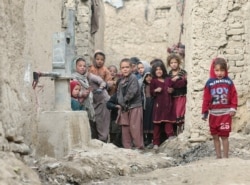The World Health Organization and UNICEF are calling for the establishment of a humanitarian airbridge to deliver lifesaving assistance to millions of vulnerable people in Afghanistan.
Since the Taliban seized control of Afghanistan, major air operations at Kabul airport have been focused on evacuating internationals and vulnerable Afghans. This operation has gone ahead at the expense of aid deliveries by U.N. agencies.
For example, the World Health Organization reports it was unable to deliver 500 tons of medical supplies this week, including surgical equipment, trauma medicines and treatments for childhood pneumonia because of Kabul airport restrictions.
Spokesman for the U.N. children’s fund, James Elder, tells VOA the WHO shipment also included nutritional food for the treatment of malnourished children.
“We fear that you could have as any as a million children under the age of five suffering from severe acute malnutrition this year. That is the most dangerous form. That is the type of malnutrition that can kill. We need to continually ensure that those supplies are on the ground, and a lot of that does take airlifts. Now, we have a lot of supplies in country, but it is not an exhaustive amount. We need to continually replenish those,” he said.
That, he explains, is why WHO and UNICEF are calling for the establishment of a humanitarian airbridge. He says this would ensure that lifesaving supplies could come into the country while evacuations were taking place.
Elder notes that conditions in Afghanistan are perilous. He says humanitarian needs remain as critical now as they were before this conflict came to a head. Even before the current crisis, he says, Afghanistan represented the third largest humanitarian operation in the world.
Since no commercial aircraft currently can land in Kabul, he says a humanitarian airbridge would allow aircraft delivering aid to continue to use the airport.
“It just requires authorities on the ground to ensure that humanitarian agencies, the big ones that do these types of things — the World Food Program, UNICEF, and of course, what we are talking here with regard to these medicines of WHO. It is what they do day in, day out, in what we call normal times. And it just needs to continue now, despite what looks like chaotic scenes at that airport,” he said.
The United Nations reports that nearly half of Afghanistan’s population, or 18 million people, among them 10 million children, require lifesaving assistance. This number includes 300,000 people who fled their homes in the last two months while Taliban insurgents were closing in on the country’s former rulers.








